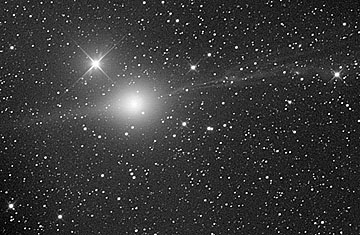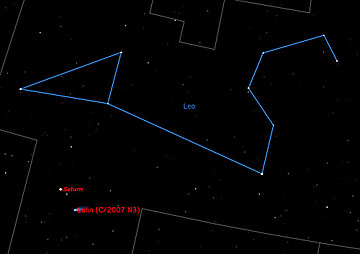
Comet Lulin (C2007 N3) was discovered in 2007 by a team of Chinese and Taiwanese astronomers centered around Lulin Observatory in Taiwan. It was originally spotted in China, and its position reported to Lulin Observatory where it was imaged and its orbit calculated. This is a remarkable example of cooperation between scientists of two countries usually thought to be at odds with each other.
At the time of its discovery in July 2007, Comet Lulin was located between the orbits of Jupiter and Saturn in the constellation Aquarius. It was closest to the Sun on January 10, but still far from Earth, 1.6 astronomical units away. By the time it reaches its prime observing period in February this year, it will be speeding through Libra, Virgo, and Leo. It will be closest to Earth on February 24, when it will be just visible to the naked eye in a really dark sky, but an easy object in a small binocular. On that date, it will be less than three degrees away from the planet Saturn, making for a remarkable sight.
Here is a view of Comet Lulin as it passed 47 Librae, captured by Canadian astronomer Paul Mortfield on January 8 using his remote telescope in Arizona:

All of this information (except for the history of its discovery), plus a whole lot more, is available to anyone using Starry NightŪ software. Starry NightŪ provides two quite different ways of looking at a comet like Lulin. First of all, you can track the comet as it wends its way through the solar system. Secondly, you can follow its actual movements in the sky. Since most people are less familiar with the first use of Starry NightŪ, I'll spend more time on that.
Starry NightŪ provides the unique opportunity to view our solar system from outside, and to navigate around it in three dimensions. This enables us to visualize the orbits and movements of solar system objects in many unique ways. Starry NightŪ comes with a number of "Favourites": preset views of the universe that we can use to explore things on our own. Let's look at one of these now.
Under the Favourites menu, choose Solar System:Inner Planets:Inner SolarSystem using the hierarchical menu system. This will show you an oblique view of the inner planets, Mercury, Venus, Earth, and Mars, surrounded by the asteroid belt. Click on the Stop button and then on the drop-down menu in the Date and Time box to choose "Now". This will give you a snapshot of the inner planets as they are located right now. You can use the "+" and "-" buttons to zoom in and out, and, from the cursor menu at the far left end of the toolbar you can select the Location Scroller cursor to view the solar system from different angles. Experiment with this cursor to see how it operates. By dragging downwards you can view the solar system from above the Sun's north pole; by dragging upwards you can view the solar system edge on.
Let's add Comet Lulin to our solar system view. Click the Find tab on the left side of the screen to open the Find pane. Click on the magnifying glass and choose "Orbiting Objects." Type in "lul" to bring up Comet Lulin. Click in the two check boxes alongside "Lulin (2007 N3)": the first labels the current position of Lulin and the second turns on its orbital line. You'll immediately see the typical comet orbit, in this case a highly eccentric ellipse since Lulin is a periodic comet. Use the Location Scroller to see how this orbit appears in both the "overhead" and "edge on" views. If you know anything about comet orbits, you'll see that Lulin's orbit is very unusual in that it is very close to the plane of the solar system, much like the planet orbits onscreen. Just for fun, add a couple of other comet orbits, say Halley and Hale-Bopp. You'll see that their orbits lie nowhere near the plane of the solar system.
Now let's follow Comet Lulin across the sky. First, add Comet Lulin to the sky the same way we did in the solar system view. Open the Find pane, limit the search to Orbiting Objects, and enter "lul". This time click only the box on the left, adding the label to the sky view. Set the Date and Time to when you plan to observe, say 5 a.m. on February 1. Comet Lulin starts the month right in the middle of the constellation Libra. If you open the Info pane, you'll find an array of information about Lulin on that date, including its distance from the Earth (0.928 au), distance from the Sun (1.259 au), and apparent magnitude (7.33).
Advance the date day by day, and you'll see the comet move across the sky, and the Info pane data change. On February 11 it leaves Libra and moves into Virgo. On February 23 it moves into Leo, and its apparent magnitude reaches its maximum (5.99). On February 24 the Comet is closest to the planet Saturn. Notice how, as the Comet gets closer to Earth, its apparent speed across the sky increases. After February 24 it moves into the evening sky and seems to slow down, moving into Cancer on March 2 and Gemini on March 9. Starry NightŪ makes a prediction of the length and direction of its tail, and notice how this changes as it passes the Earth. Remember that comets' tails always point away from the Sun.

As David Levy likes to say, comets are like cats: they both have tails and both do exactly as they please! Starry NightŪ shows Comet Lulin as it would appear if it were a well-behaved comet, but there really is no such thing. I'm sure Comet Lulin will give us a surprise or two, so I hope you will join me in trying to observe this interesting visitor to our part of the solar system. Clear skies!
February 2009
Geoff has been a life-long telescope addict, and is active in many areas of visual observation; he is a moderator of the Yahoo "Talking Telescopes" group.













